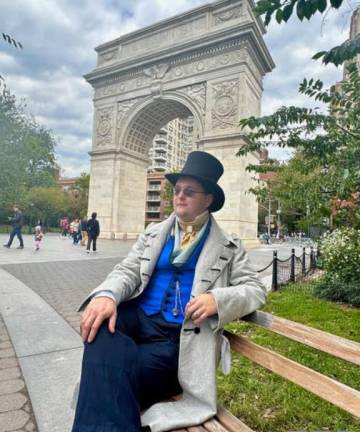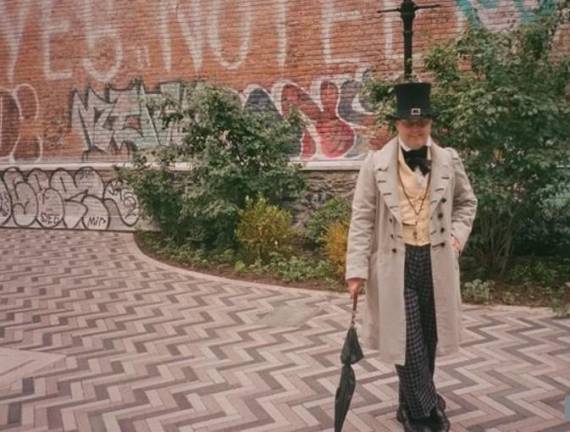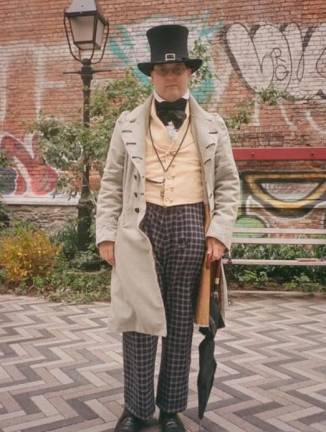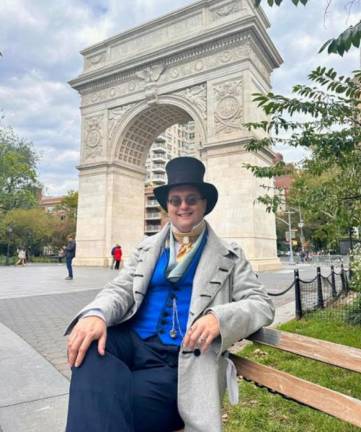Artist in a Top Hat Strolls Through the City
Prowling museums and graveyards, a 25-year-old fashion designer pushes for historical accuracy in period pieces and hopes for his big break.




Adam Pajkowski dresses as if he belongs on the streets of early Victorian-era Paris, a picturesque image of a 6-foot upper-middle-class man heading to the local brasserie. But the first time I saw him, he was swiftly crossing the street toward the Merchant’s House Museum in downtown Manhattan. The 25-year-old Queens native was decked out in meticulously crafted 1830s menswear, most of which he designed and made himself.
Waiting for the museum to open, he checked the time on his functioning 1850s silver-plated pocket watch, which winds up using its original key. Even though it was the first time he had worn this eye-catching ensemble in public, Pajkowski carried himself with confidence and ease. Typically, he leaves the house in what he calls a “history-bounded” outfit, blending one piece from the past with contemporary clothing. Dressing in full regalia, he purposefully wanders the streets of Manhattan, anywhere from Central Park to a cemetery on the border of Brooklyn and Queens–he secretly loves the attention.
His attire suggested he worked as a tour guide at the city’s only preserved nineteenth-century family home, which he doesn’t. When I inquired about his outfit choice, Pajkowski simply replied, “For fun... it’s my day off.”
But we both knew it was beyond that.
“It’s the collective story of humanity,” he explained. “If you don’t understand how many factors have led to the absolute cosmic accident of your own existence, you don’t appreciate yourself, your time or things around you.”
Pajkowski calls himself a history nut. He claims if you were to name any 90s tween age ghost book, he has most likely read it or is at least familiar with the author. And this passion is a family affair. Before the pandemic, he and his cousin Kristen, 25, would spend “time-traveling” days together, visiting transit museums and taking photos in old subway cars wearing period-accurate outfits.
Now, Adam spends his free time exploring old cemeteries, often joined by his mother, Carolyn, who taught him the basics of sewing when he was 10.
Although he broke his first sewing machine within a minute of receiving it on Christmas Day, the young tailor gradually improved, producing hand-made garments and dresses for 11-inch Barbie dolls during his preteen years. This early experience led him to earn a BA in Fashion Design and Production from Lasell University in 2019. Currently, he is enrolled in an eight-week online costume design certification course at the Fashion Institute of Technology. The course is taught by Professor Michael Harrell, the 67-year-old Manhattan costume designer who has created, tailored and styled clothes for icons like Patti LaBelle, Lenny Kravitz, Britney Spears and Harry Styles. He has spent over a decade working in the costume department for the Broadway show “The Book of Mormon.”
Adam hopes to become a professional historical costume designer, and he has a plan. First, earn an MA in Fashion and Textile Studies at FIT, and then go on to rectify historically inaccurate costumes in TV and film and craft period-appropriate pieces. He also wants to participate in historical restoration villages like New York’s Old Bethpage Village or Richmond Town in Staten Island.
But for now, he can’t quit his steady day job; someone’s got to pay the bills. It’s a harsh reality looming throughout this notorious city of dreamers, yet the hustle remains.
The young designer enjoys the quirkiness of clothing from the less popular transitional periods in fashion history, like the 1820s and 1830s. He intentionally incorporated a wide lapel to create an M-shaped contour along the sides of his frock coat, a signature feature from the early 1800s. He also admires the feminine touches that influenced men’s attire during this era, including hourglass silhouettes, puffy sleeves, wide coat skirts, bold pops of color and elaborate patterns–although these fashion trends were relatively short-lived.
“The cisgender men are left in the dark in terms of ‘you wear what you wear,’ and if you have any interest in making yourself look good in that clothing, you’re gay. I mean, I’m gay, but you know, whatever... I really don’t care what people think.”
The young man’s fashion sense is both whimsical and purposeful. His dandified aesthetic is the catalyst for the deeper discussions he hopes to facilitate.
“Vintage style, not vintage reality,” he chuckled, referring to a common phrase in the historical cosplay community. “I love the aesthetic, but I’m glad I live in the 21st century where I would not be lobotomized. I have my Wi-Fi, my cell phone and my iced coffee.”
His approach to history is nuanced, as he cherry picks what he deems most beneficial for improving current-day society. His process excludes anything produced due to slave trading, fetishization, racism, sexism, homophobia, misrepresentation–all the behaviors and practices he prefers to leave in the past.
Adam’s idiosyncrasy is an undeniable conversation starter, and sometimes, people just want to talk, or comment, or both.
“Are you Mr. Conductor from Thomas the Train?” shouted Anthony Hinojosa, a 21-year-old New York native from Queens sitting on a platform in Washington Square Park.
“You must be Slash’s dad!” yelled a middle-aged man in baggy clothing while three large dogs yanked him by their leashes. We assumed he was referring to the Guns N’ Roses’ lead guitarist.
And some random encounters evolved into more substantial interactions.
Adam caught the attention of a former pattern maker and costume designer–Patrick Simpson. A native of Jamaica who has lived in Manhattan for nearly six decades, tall and slender with thin dreadlocks. Some may recognize him better as “Electric Dread,” his stage name as a music engineer.
He tells us that he previously worked for the Philadelphia Costume Company, creating extravagantly vibrant costumes filled with sparkling sequins and ruffled feather textures for the Mummer’s Parade, a Philadelphia folk parade traditionally held on New Year’s Day for over 120 years.
When I asked Simpson about his thoughts on Pajkowski’s self-tailored outfit, he paused momentarily and reflected.
“No padding, but it’s working,” he replied. Little did he know the coat alone cost Pajkowski nearly seven months of trial and error and, ultimately, a large dent in his wallet.
Strolling around downtown Manhattan, I asked Pajkowski if he planned on dressing like this more frequently.
“God, no! I work in retail,” he replied in between laughs. He is currently working in the stock department at TJ Maxx. It pays the bills.